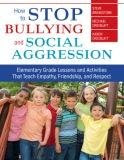Recently, I read the article Brain Scans Show Bullies May Enjoy Watching Pain. The study, using sophisticated fMRI technology, suggested that kids who bully derive pleasure from others pain.
I’m completely in favor or research to gain greater insight into the dynamics of bullying and determine new strategies to reduce violence and increase empathy and respect. Unfortunately, I don’t think the information of this study, as publicized, is all that relevant in terms of bullying. The researchers studied the brain activity of 8 teenagers with aggressive Conduct Disorder (CD) and another 8 matched controls that did not show symptoms of CD, while they watched animated scenes showing people in pain and not in pain. All the subjects were boys between 16 and 18 years of age.
Conduct disorder is described as a group of behavioral and emotional problems in youngsters. Children and adolescents with this disorder have great difficulty following rules and behaving in a socially acceptable way. They are often viewed by other children, adults and social agencies as "bad" or delinquent, rather than mentally ill. Many factors may contribute to a child developing conduct disorder, including brain damage, child abuse, genetic vulnerability, school failure, and traumatic life experiences.
People with this disorder have a very serious issue and special needs. However, they do not make up the majority of kids who bully. Conduct disorder only affects 1 to 4 percent of 9- to 17-year-olds.
Bullying shows itself in many different forms (physical, verbal, cyber and relational), is common among male and female of all ages and is expressed for many different reasons. It is a behavior that meets a need which can include, but not be limited to, a desire to be popular, a leader, considered funny, impress peers, or seek revenge. If the behavior is reinforced with success in meeting the need of the child, the behavior will continue. The study focused specifically on how the subjects reacted when viewing physical types of distress in others. However, physical bullying is the least common type of bullying. And aggressive behavior by kids with conduct disorder is only one small fraction of those guilty of bullying.
This study seemed to get a lot of publicity with its headlines, but I would caution about thinking that it offers any new important insights into the general bullying dynamic. I think it’s too early to equate it with bullying at all. This study was too limited in scope to be of any real value in bully prevention strategies. I think it was way too early to even publish this study, especially in regards to new insights about bullying, but I do hope they continue the research.
What do you think?
Steve
Friday, November 14, 2008
Subscribe to:
Post Comments (Atom)



1 comment:
I would love to see a longitudinal study using this technology and methodology to investigate if this difference in brain response to such stimuli might actually develop over time in subjects who play violent video games.
Post a Comment